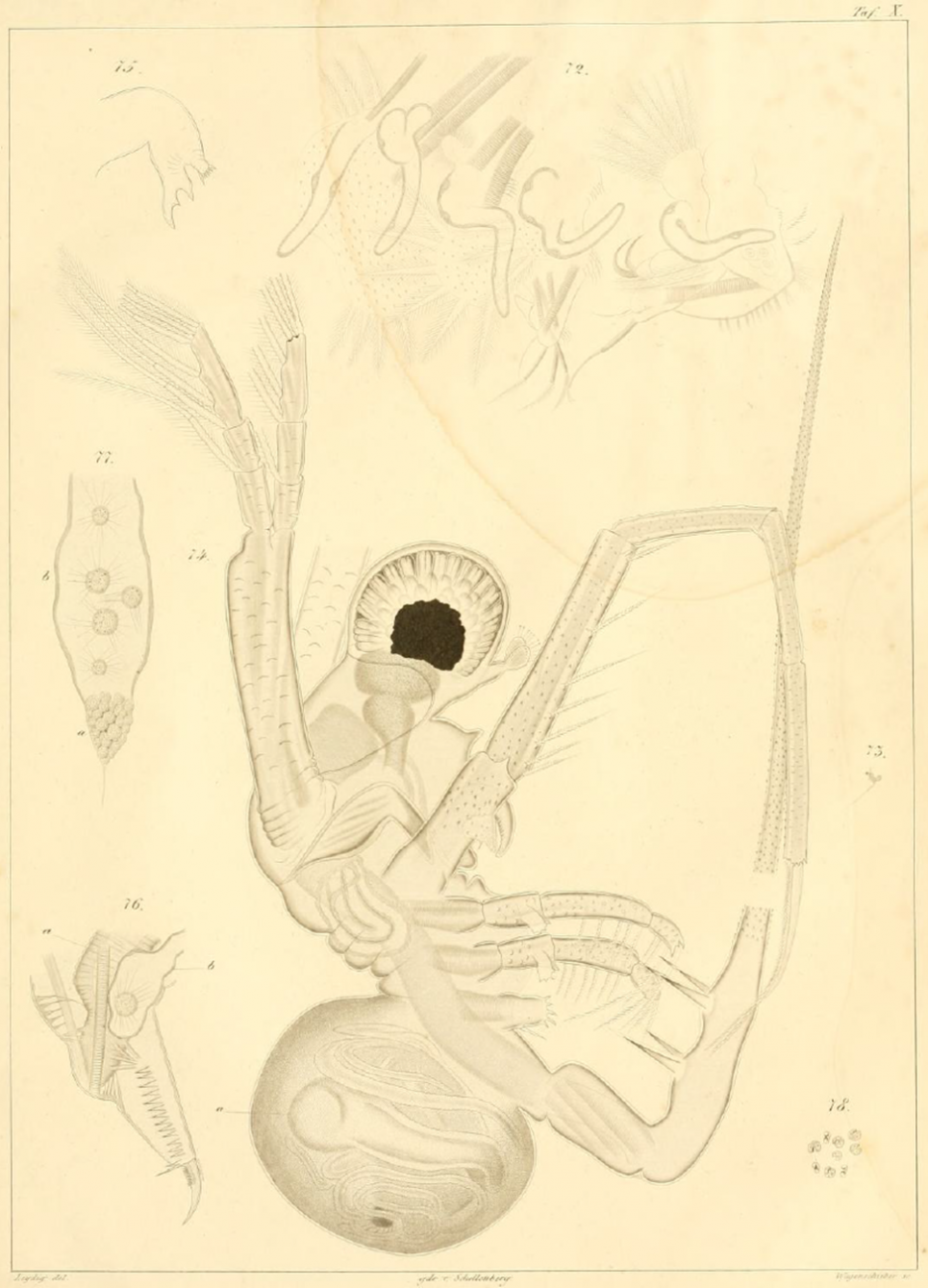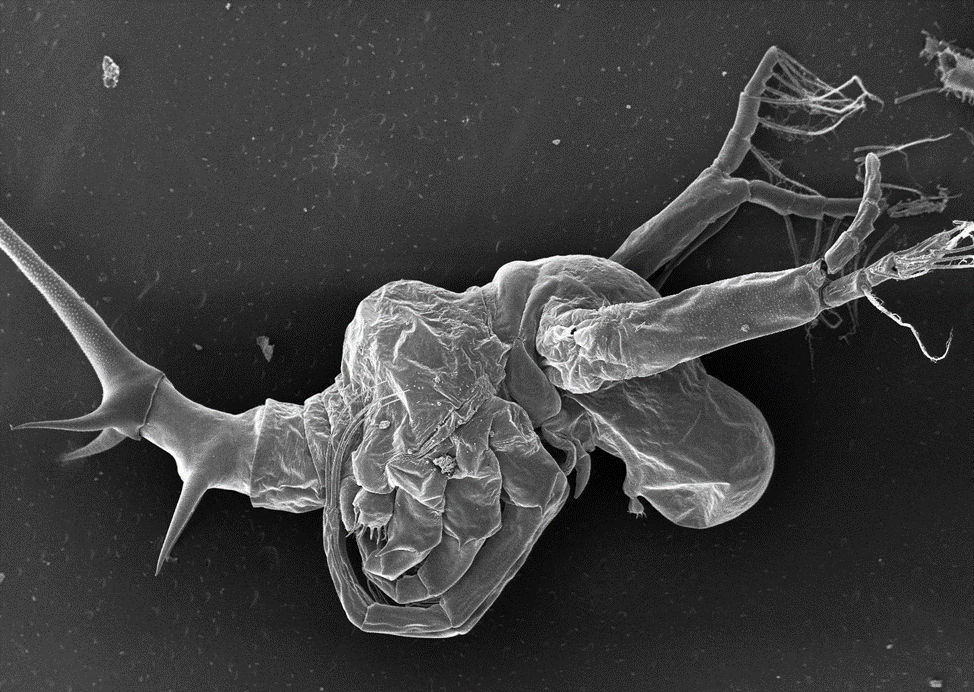
Currently, human activity plays a key role in the movement of species to new habitats. Despite the huge number of dispersed species, only a small part of them become invasive, that is, harming local communities, associated with enormous ecological and economic damage. According to the most conservative estimates (Cuthbert et al., 2021), the damage from alien species in aquatic systems alone exceeds $ 300 billion, with exponential growth over the past decade. And while some alien species are widely known (for example, the agricultural pest - the Colorado potato beetle or the fouling organism - the zebra mussel), we often do not notice others, although the damage from them can be no less severe.
The microscopic branched crustacean Bythotrephes longimanus, or spiny water flea, is a tiny aquatic predator native to the Ponto-Caspian basin. This small predator, hovering in the water thanks to a well-developed compound eye, tracks down prey and actively catches it due to its well-developed locomotor apparatus. Bythotrephes attack almost all planktonic animals, even those significantly larger than themselves, not disdaining their own young, but do not touch sedentary and temporarily attached crustaceans (such as Sida and Simocephalus). Due to such active swimming, this crustacean has a very important morphological adaptation: a thin and very long tail appendage follows the compact body, which serves both to increase the hovering area and to create a straight line of movement, ensuring the stability of the course of this crustacean. It is these features - the long tail spine and the "bloodthirstiness" of the crustacean - that have caused great scientific interest. In aquatic ecosystems of the historical part of the range, for example, in the north of Europe, this species, although capable of reaching high numbers, does not greatly affect local communities. And a completely different situation developed when this species got to the New World. At the beginning of the century, Bythotrephes crustaceans massively settled in the North American Great Lakes. American fishermen were the first to notice these crustaceans: Bythotrephes tail spines cling to fishing lines and clog fishing gear, which has a catastrophic effect on fish catches. Bythotrephes also feeds on small zooplankton, such as small cladocerans, copepods and rotifers, directly competing for food with planktivorous fish larvae. The fish themselves, and especially the fry, also suffer direct harm: when eating bitotrephs, due to their long tail needle, the delicate mucous membrane of the fish's digestive system is injured, mechanically damaged and perforated, which leads not only to illness, but also to mass death of fish, in particular lake herring (Alosa pseudoharengus) in the Great Lakes (Liebig et al., 2021). The total damage to the Great Lakes fisheries is estimated at more than $ 100 million per year (USEPA, 2022). But this is not the only direct damage inflicted on American ecosystems. In a short time, the spiny water flea ate more than half of the biomass of all small filter-feeding crustaceans (primarily Daphnia pulicaria, a key filter feeder that ensures clean water in eutrophic reservoirs of North America).

As a result, small algae and cyanobacteria now thrive in the lakes, and their transparency has sharply decreased. According to American experts, the damage from increased water turbidity for Lake Mendota alone exceeded $140 million (Walsh et al., 2016), and the cost of restoring only the ecosystem service of “clear water” for this lake will amount to more than $800 over 20 years for each resident of the coastal zone - an impressive amount, even for US citizens.
The work of a large group of authors is devoted to the study of this small but extremely important planktonic predator. The work was published in one of the oldest and highest-rated zoological journals - Zoological Journal of the Linnean Society. Russian scientists played a key role in this study. Thus, the collection and processing of material from the Russian side was carried out by D.P. Karabanov from the I.D. Papanin Institute of Biology of Inland Waters (IBW RAS), and the general supervision of the work was carried out by Corresponding Member of the Russian Academy of Sciences A.A. Kotov from the A.N. Severtsov Institute of Ecology and Evolution of the Russian Academy of Sciences (IEE RAS). Despite such a relevant topic, knowledge about Bythotrephes crustaceans is extremely limited. Thus, even the taxonomic status of Bythotrephes has been discussed for more than 150 years, which indicates the complexity of the classification of this genus. To resolve this issue, the scientists used an integrative approach to taxonomy, which included multigene analysis: four crustacean genes from 80 populations representing at least four morphotypes from different regions (North America, Europe and Asia) were studied to clarify the taxonomic status of Bythotrephes.
The results obtained convincingly support the hypothesis that Bythotrephes is a single species, namely Bythotrephes longimanus Leydig, 1860. The scientists suggest that the various morphotypes should be considered ecological forms and accepted as junior synonyms of this species. The study also points to a recent morphological radiation in this species, which may have occurred rapidly and in parallel in the late Pleistocene or shortly after the last glaciation. This suggests that the evolutionary history of these crustaceans is closely linked to climate change.
The conducted biogeographic reconstruction of the distribution of Bythotrephes in the Holarctic showed that Europe probably served as a distribution center, from which the crustaceans spread relatively recently, possibly within the last 10,000 years. Several paleographic events are proposed that are important for understanding the biogeography and evolutionary dynamics of Bythotrephes. The study has not only practical application in the form of refining the diagnostic features of Bythotrephes, which is important not only for taxonomic purposes but also for applied identification of crustaceans, but also allows us to understand the historical mechanisms of dispersal of this species in the Holarctic, and therefore to develop methods for combating and controlling unwanted alien species.
The work was published in the Zoological Journal of the Linnean Society: A rapid and parallel Late Pleistocene/Holocene morphological radiation in a predaceous planktonic water flea: the case of Bythotrephes (Cladocera: Cercopagididae), Maciej Karpowicz, Dmitry Karabanov, Magdalena Świsłocka-Cutter, Łukasz Sługocki, Elizabeth A Whitmore-Stolar, Joseph K Connolly, James M Watkins, Alexey A KotovZoological Journal of the Linnean Society, Volume 202, Issue 3, November 2024.
Related materials:
New Science: "A Microscopic Predator with a Global Impact: Scientists Investigate Bythotrephes longimanus"
Encyclopedia of Technology: "A Microscopic Predator with a Global Impact: Scientists Investigate Bythotrephes longimanus"
